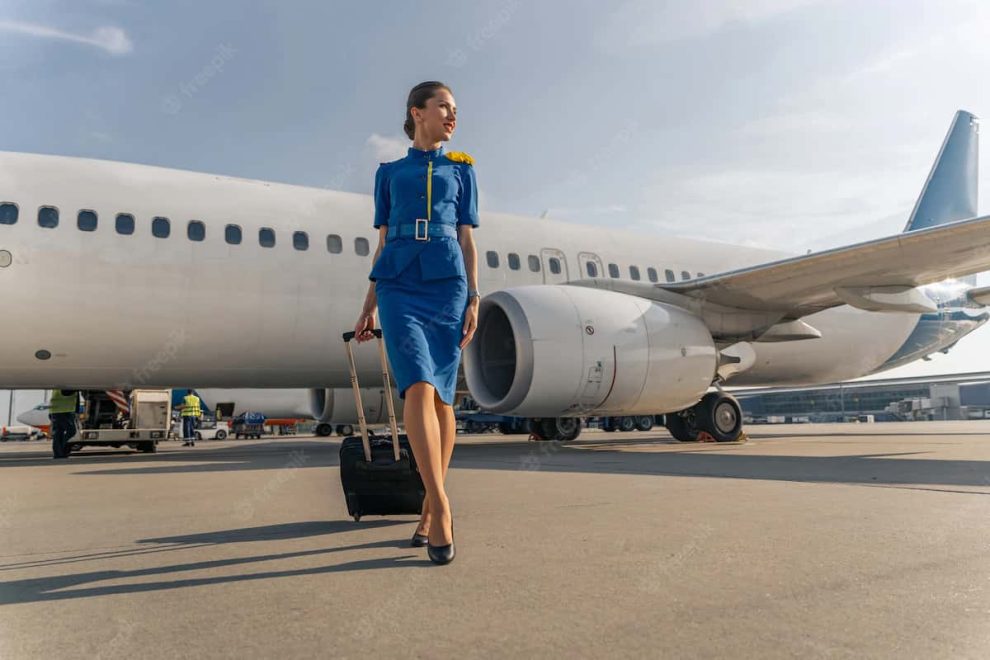Have you ever wanted to travel the world, but didn’t know how to make it a reality? A career as a flight attendant may be the perfect solution for you! You’re probably wondering about the best way to go about it. The first step is to find a flight attendant school that offers training and courses for flight attendants.
Flight attendants are responsible for the safety and comfort of passengers during flights, and they have the prospect to travel to different parts of the world on a regular basis.
If you’re interested in becoming a flight attendant, you’ll need to complete some training first.
In this article, we’ll cover everything you need to know about flight attendant courses and training, including what you’ll learn, how much it will cost, and where you can find programs.
What are the requirements to become a flight attendant?
The job of a flight attendant entails providing excellent customer service to airline passengers while ensuring their safety and comfort. Below, we outline the key requirements you’ll need to meet to qualify as a flight attendant.
Minimum age:
Most airlines have a minimum age requirement of 18 or 21 years old, although some may require that you be at least 25 years old.
Language skills:
Fluency in English is typically required as it is the language of aviation. However, a number of airlines also require fluency in one or more additional languages, particularly if they operate internationally. For example, Delta Air Lines lists Spanish, French, Mandarin, and Japanese as preferred languages for their flight attendants.
Customer service experience:
While not always required, many airlines prefer candidates who have prior experience working in customer-facing roles such as retail, hospitality or tourism. This experience can help you better understand the needs of customers and how to provide outstanding service.
Education:
There is no formal education requirement for becoming a flight attendant, although most airlines prefer candidates who have completed high school or earned a GED equivalent. Some airlines may also require that you have completed some college coursework, particularly if you’re applying for an international role where language skills are required.
What is the job outlook for flight attendants?
The job outlook for flight attendants is very positive. The flight attendant job market is expected to grow at a rate of 10.2% from 2016-2026. In large part, this growth can be attributed to the increasing demand for air travel. As the economy continues to improve, more people are taking vacations and business trips, which requires more flights and therefore more flight attendants.
There are currently about 130,000 flight attendant jobs in the United States, and this number is expected to increase to 139,000 by 2028. The majority of flight attendant positions are with major airlines, but there are also opportunities with regional airlines, charter companies, and private jet operators.
Flight attendants typically work on a rotating schedule that includes days, nights, weekends, and holidays. They may be away from home for several days at a time and have irregular hours. Because of this, it can be difficult to maintain a healthy work-life balance. However, most airlines offer perks such as free or discounted travel that can help offset some of the challenges of the job.
How much do flight attendant courses cost?
While the cost of flight attendant courses can vary depending on the provider, most courses will fall in the $1,000 to $3,000 range. Some providers may offer discounts for students who pay in full upfront, so it’s always worth checking for deals.
Once you’ve completed your course, you’ll need to take a certification exam from the Federal Aviation Administration (FAA). The cost of this exam is currently $200.
In total, you can expect to spend around $1,200 to $3,200 on training and certification to become a flight attendant. While this may seem like a lot of money upfront, keep in mind that most airlines will reimburse you for the cost of your training once you’re hired.
What is included in flight attendant courses?
Most courses will cover topics such as aircraft safety procedures, emergency medical procedures, customer service skills, and passenger handling. In addition to classroom-based learning, you can expect to get some hands-on experience with emergency equipment and evacuation slides.
Some providers may also offer additional modules at an extra cost. These could cover topics such as dealing with disruptive passengers, cultural awareness, or conflict resolution.
Are there any cheaper alternatives?
While taking a certified course is the best way to prepare for a career as a flight attendant, there are some cheaper alternatives available. For example, many airlines offer “open days” where they provide an overview of what the job entails and allow interested individuals to try out some basic safety procedures.
Are there any scholarships or financial aid options available?
The cost of flight attendant courses can be a major barrier to entry for many people interested in the field. However, there are a number of scholarships and financial aid options available to help offset the cost of training.
One option is the Flight Attendant Tuition Reimbursement Program, which is offered by a number of airlines. Under this program, airlines will reimburse a portion of the cost of flight attendant courses for employees who successfully complete their training and meet certain other criteria.
Another option is scholarships specifically for those interested in becoming flight attendants. These scholarships are typically awarded based on financial need and/or academic merit. A quick search online will reveal a number of different scholarship opportunities.
Finally, many schools that offer flight attendant courses also have financial aid options available for students. This can include grants, loans, and even work-study programs. Be sure to check with your school’s financial aid office to see what options may be available to you.
How long do flight attendant courses take to complete?
Most full-time programs take between 4 and 8 weeks to complete. Some airlines offer part-time or home study programs that can take up to a year to finish.
The first few days of training are usually spent in the classroom, learning emergency procedures and other safety information. The rest of the time is spent on the aircraft, where you will learn how to deal with passengers, serve food and drinks, deal with onboard emergencies, and handle the various duties of a flight attendant.
Some airlines also offer refresher courses for experienced flight attendants who need to update their skills or learn new procedures. These courses usually last a few days or weeks.
What should I look for in a flight attendant course?
When you are looking for a flight attendant course, there are a few things you should keep in mind. First, the course should be accredited by a reputable organization. This will ensure that the course meets high standards and will give you the skills you need to be a successful flight attendant.
Second, the course should be comprehensive, covering all aspects of the job. From customer service to safety procedures, you should make sure that you are getting everything you need to know.
Third, the course should be taught by experienced instructors who have actually worked as flight attendants. This real-world experience will be invaluable as you learn the ropes.
To wrap things up
So there you have it! The cost of becoming a flight attendant can be expensive, but there are many options to finance your training. So, you can go ahead and fulfill your dream of flying across the length and breadth of the planet helping so many on the way.












Add Comment